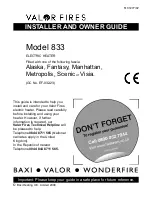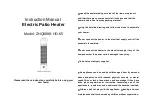
10
Water Piping
HOTTER WATER CAN SCALD: Water heaters are intended
to produce hot water. Water heated to a temperature which
will satisfy clothes washing, dish washing, and other sanitizing
needs can scald and permanently injure you upon contact.
Some people are more likely to be permanently injured by
hot water than others. These include the elderly, children, the
infirm, or physically/mentally handicapped. If anyone using hot
water in your home fits into one of these groups or if there is a
local code or state law requiring a certain temperature water
at the hot water tap, then you must take special precautions.
In addition to using the lowest possible temperature setting
that satisfies your hot water needs, a means such as a mixing
valve* should be used at the hot water taps used by these
people or at the water heater. Mixing valves are available at
plumbing supply or hardware stores. Follow manufacturers
instructions for installation of the valves. Before changing
the factory setting on the thermostat, read the “Temperature
Regulation” section in this manual.
See Figure 8 for mixing valve usage.
FIGURE 8.
Figure 9 shows the attachment of the water piping to the
water heater. The water heater is equipped with 3/4” water
connections.
If a water heater is installed in a closed water supply system;
such as one having a back-flow preventer, check valve, water
meter with a check valve, etc... in the cold water supply;
means must be provided to control thermal expansion.
Contact the local utility or Sears Service Center on how to
control this situation. See “Thermal Expansion.”
Also, the water supply pressure should not exceed 80 psi. If
this occurs, a pressure reducing valve with a bypass should
be installed in the cold water inlet line. This should be placed
on the supply to the entire house in order to maintain equal
hot and cold water pressures.
NOTE: If using copper tubing, solder tubing to an adapter
before attaching the adapter to the water connections. Do
not solder the water supply lines directly to the connections.
It will harm the fittings on the water heater.
NOTE: To protect against untimely corrosion of hot and cold
water fittings, it is strongly recommended that di electric
unions or couplings be installed on this water heater when
connected to copper pipe.
1. Look at the side of the water heater. The hot water outlet is
marked hot. Put two or three turns of Teflon
®
tape around the
threaded end of the threaded-to-sweat coupling and around
the 3/4” threaded nipple. Using flexible connectors, connect
the hot water pipe to the hot water outlet of the water heater.
2. Look at the side of the water heater. The cold water inlet is
marked cold. Put two or three turns of Teflon
®
tape around the
threaded end of the threaded-to-sweat coupling and around
the 3/4” threaded nipple. Using flexible connectors, connect
the cold water pipe to the cold water inlet of the water heater.
FIGURE 9.
NOTE: Your water heater is insulated to minimize heat
loss from the tank. Further reduction in heat loss can be
accomplished by insulating the hot water lines from the
water heater.
Содержание 153.316050
Страница 3: ...3 GENERAL SAFETY ...
Страница 25: ...25 NOTES ...
Страница 26: ...26 NOTES ...
Страница 27: ...27 NOTES ...











































